New

Small but delicate woodcarving done by Balinese master Ida Bagus Tantra.
1950-1960
According to Bali expert Bruce Carpenter it was Tantra who introduced the Botero style on Bali.
Tantra was a nephew of the great Ide Bagus Njana.
Rudolf Bonnet made a portrait of him in 1974, see the last 2 photos.
If you click on the photo there is more info&photos.
|
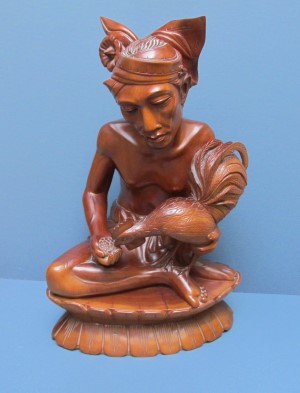
Balinese man with his fighting cock
1940-1960
|
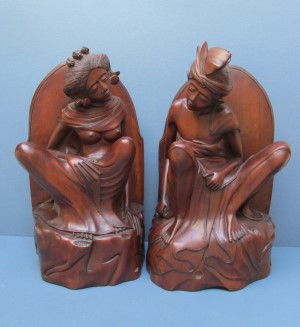
Bookends from the 1950s, made for the tourists on Bali.
Pls click on the photo for more photos&info
1950-1970
These bookends were made by a very accomplished Balinese woodcarver;
many technical hurdles must be overcome.
The last photo shows a similar couple made around the same time.
|
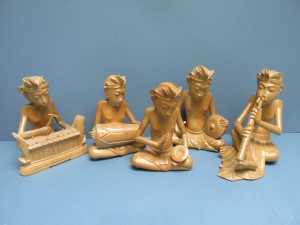
Gamelan orchestra
1960-1980
|
New

Woodcarving of a goat
1950-1970
Good example of small carving done by an accomplished artist. This goat was made for the tourist market; no doubt about that. And maybe he was able to finish this in a day. But still such a goat is pretty hard to create, and the result is great; full of class and humor. Maybe Ajun was enjoying himself!
|
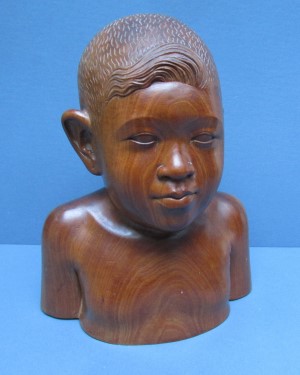
Wooden bust of a white boy made by a Balinese woodcarver.
1950-1970
Remarkable bust, made of heavy wood, and most likely carved as a result of a special request from the parents.
On Bali most of the visiting tourists wanted to take home a souvenir. Many chose a woodcarving, and busts, especially djanger busts, were very popular.
This young boy does not fit in the above mentioned category.
The gifted carver paid a lot of attention to details, and maybe the parents chose this carver for his bust-making reputation.
|

Houten beeld van een panter, gemaakt op Bali
1950-1970
Good example for a correct wood choice by the carver. By choosing pallissander wood, with its distinctive flamed pattern, it resembles the outerskin of the panter.
A carving full of expression!
Pls click on the photo to get more info and photos.
|

Old bust of a Balinese djanger dancer
Made as souvenir.
1970-1990
This bust was made when sores of tourists invaded Bali in the 1970-80
|

Wooden bust of a Balinese woman
1960-1980
Made of heavy ebony wood.
The carver was employed by the Njana-Tilem Gallery in Mas, Bali
|
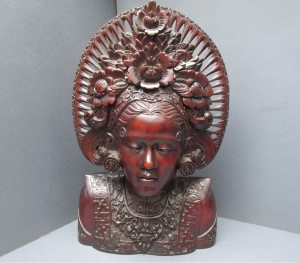
Bust of a djanger dancer
1940-1950
Exquisite large bust of a Balinese djanger-dancer. Many busts like this have been made on Bali but this one is much bigger than usual and also much more detailed. The crown is carved as detailed as possible and the flowers are magnificent. The dress of the dancer has been copied in detail with all the ornaments that are so typical for a djanger-costume. Also the back of the carving is beautiful. Pay attention to the little flowers in her hair! A bust of this size and magnitude is a must for Bali-collectors. Pls click on each photo to see two larger images.
|
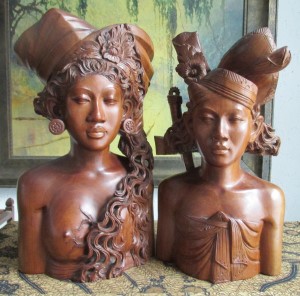
Bali couple, a loro blonyo
1960-1980
The Loro Blonyo is given to newly weds at a wedding to secure a long and happy marriage.
This pair is probably made for the tourist market by a very accomplished carver.
Heavy dense wood, with beautiful patin.
Signed under the base; A A Oke
|
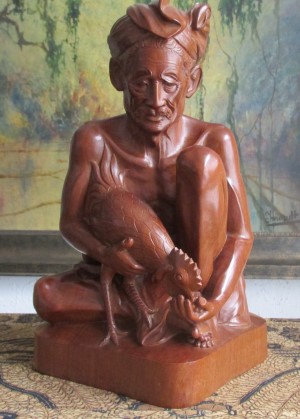
Balinese man with his fighting cock
1950-1970
Well carved statue and about the same as Tobo 641.
Cock fighting was important in the daily life of the Balinese for most of the 20th century. That's why many artists chose this subject.
|
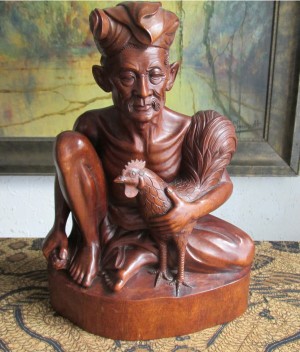
Wooden sculpture of a balinese man with his fighting cock.
1950-1970
Well carved old Balinese man with his most valuable possession; his fightting cock
|
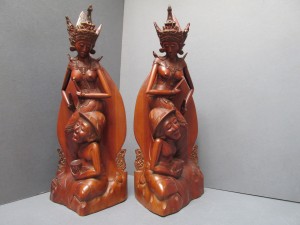
The Ramayana God Siwa has transcended into a shepard in order to try out his wife, Batara Giriputri.
1950-1960
Rare bookends when it comes to the subject. The Tropen Museum in amsterdam has a similar satue in its collection. I never saw any other Bali carving with the same subject.
|
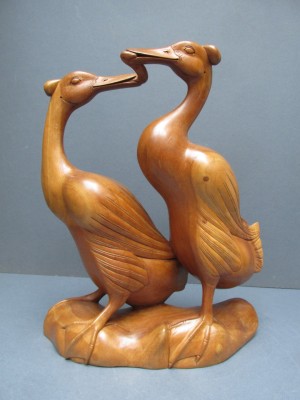
Wooden sculpture of two ducks in love-pose.
1950-1960
ToboArtSales owned once a pair of deers in a love pose(last photo). These ducks express the same metaphor; because homosexuality is not fully accepted in Indonesia, it is expressed in objects like this carving
|
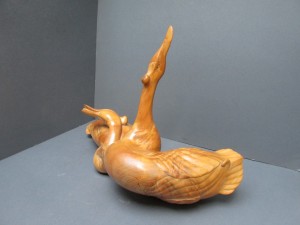
Wooden sculpture of 2 ducks
1970-1990
Nice decorative statue from the Njana-Tilem Gallery, which is known for its quality carvings.
Here is a statue of two ducks glued together in a very original manner.
|
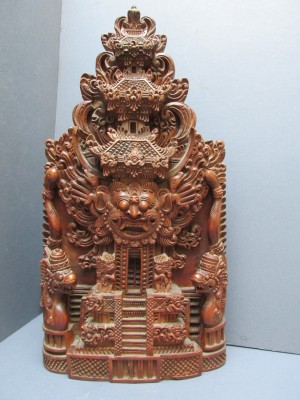
Bali temple as woodcarving-item
1950-1970
Good example of a decent tourist piece.
Well carved details.
|

Loro Blonyo
1940-1960
These 2 busts were given to a newly wed couple.
|

Carvings from the village of Sebatoe
1970
|

Crane with upstanding wing
1950-1960
Beautiful crane with detailed carving.Art deco features.
|
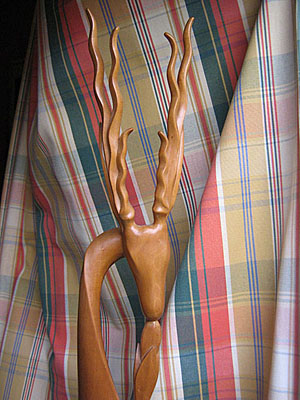
Deer
1950-1970
Nice stylistic lines
|
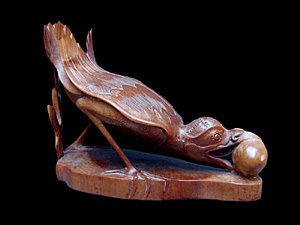
Bird with egg
1960-1970
Fine example of a better touristic carving, made when more and more tourists were going to Bali in the sixties. It is a small and compact item, ideal to take with you in a bag or trunk. The stylistic lines resemble the art deco style of the 1930s carvings.
|
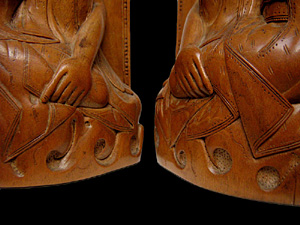
Bookends man and woman
1945-1955
Well executed bookends. Made just after World War 2. In those days the Bali carvers were still producing quality products, although they were working for the tourist market. If one looks at the details at the lower parts of both bookends, there is quite some detail, which would disappear in later years. Bookends were popular in those days, considering the number of bookends that were produced at that time.
|

Sitting man with headdress and sirih bag.
1950-1960
Although this carving was made for the tourist industry, it shows a remarkable quality and a distictive way of carving. The way the face has been carved and the superb execution of the headdress points to a mastercarver. The smaller statue,once in the ToboArt collection, has been carved by the same master.
|
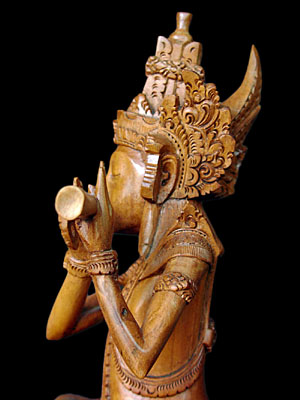
Man playing flute
1945-1960
Rare sculpture of a fluteplayer. Certainly not a mass-product considering the difficulties and structures of the carving. Made in the period right after world war 2.
|
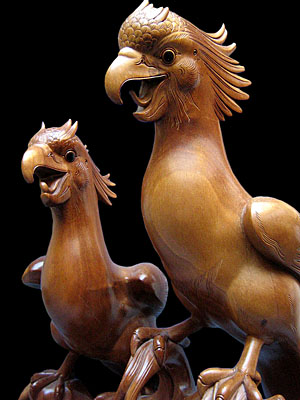
2 parrots on a base with their offspring
1940-1950
Nice birdsculpture of 2 parrots with their offspring. Probably made as a special request of a Dutchman. Made on Bali or Java during the 1940s. Heavy wood.
Pls click on each photo to see two larger images.
|

wooden sculpture of a hanuman
1950-1970
Funny sculpture of a hanuman upside down. The artist probably wanted to create something completely different than the existing carvings. No doubt he had to use all his skill to finish this difficult carving. Made for the tourist but as an art object interesting and a proof of the endless creativity of the balinese woordcarvers, probably the best in whole South East Asia.
|
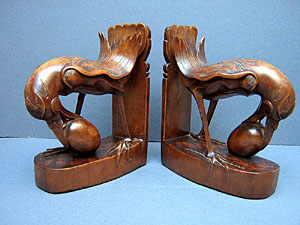
Bird-bookends.
1940-50
Nice and good carving, made for the export to Java and europe, many times copied.
|
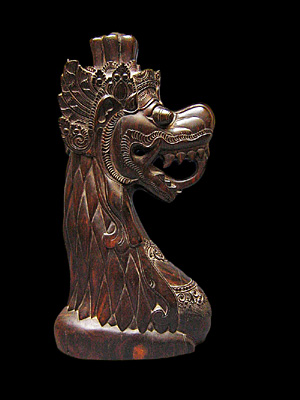
Dragon.
1945-55
Carved by the well known Balinese artist Ida Bagus Anom, who was also a good painter.
|
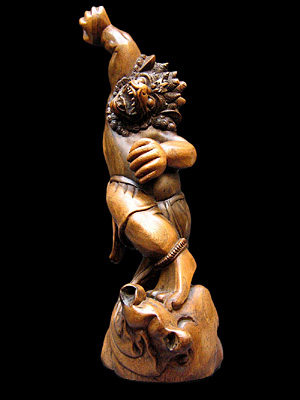
Roaring Hanuman. Nicely carved in a Botero-style. Special attention on the thick claws.
1945-55
Funny and odd woodcarving for a balinese. Maybe the artist got inspired by a picture of an European sculpture (Botero?).
|

Balinese man.
1950
|
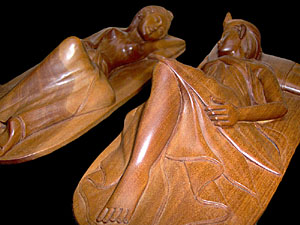
Lying balinese man and woman.
1950-1960
Rare duo carving of a Bali man and woman. Carved with very high skills.
|

Beautiful carved wooden panel.
1950-1960
|

Little dragon.
1960-1970
very small but delicate carving
|
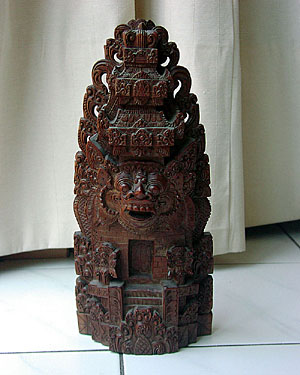
Statue of a temple made of wood.
1960
Made for the tourists.
|
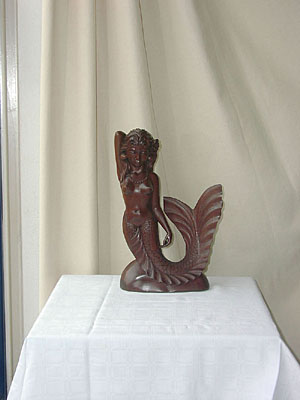
Sea mermaid.
1960-1970
Although made for the touristindustry, very rare.
|
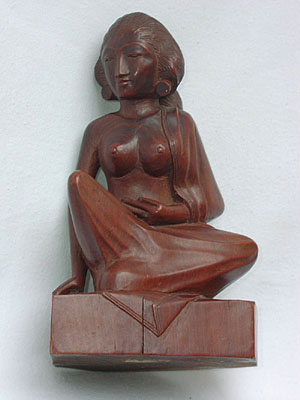
Sitting balinese woman.
1940-1950
|
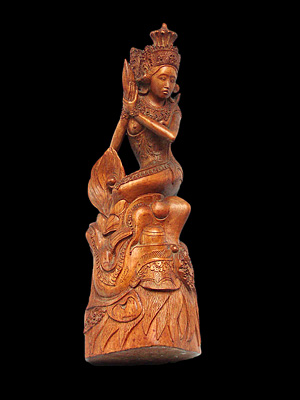
Lunar eclipse
1960-1970
The deamon Kala Rahu tries to eat the goddess of the moon Dewi Ratih.
In heaven Vishnu decaptivates the head of Kala Rahu. But after drinking a powerful serum which gives immortality, Rahu's head survives. Seeking revenge Rahu tries to deprive the gods of light by trying to eat the sun and the moon.
In modern version the moon(or sun) has been replaced by the goddess Dewi Ratih.
|
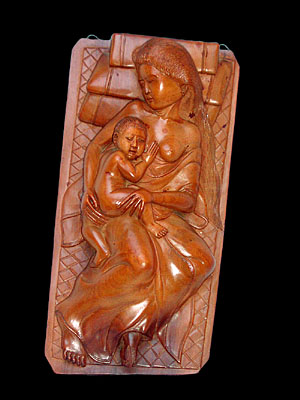
Mother and child sleeping.
1950-1960
Nice intimite mother-child sculpture. The skilled artist had to overcome several technical difficulties to get this result.
|

Wooden sculpture of a farmer working on the land. Made on Bali.
1940-1960
Popular scene for artists, woodcarvers and painters, in the fifties.
|

Flute player standing on a deer.
1940-1950
|

Bookends of Birds feeding their young ones.
1940-1950
Relative rare because depicting the young birds made it more labour intensive. In the more usual bird carvings there is an egg.
|
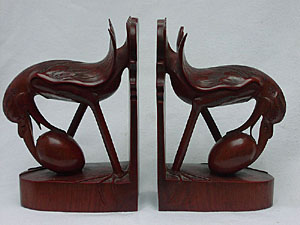
Bookends of Birds picking up an egg.
1940-1950
A typical exportproduct of Bali to Java and Europe in the fifties.
|

Two birds with their prey in their mouth.
1970
This carving was made for the tourists. But by looking at the very thin legs of the birds, this had to be the work of a skilled woodcarver. Very decorative.
|

Legong-dancer.
1960
|
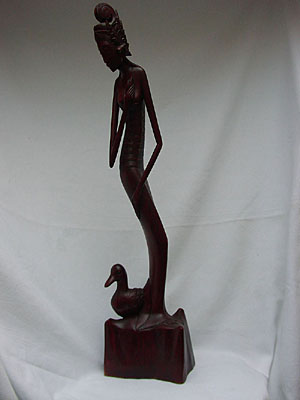
Standing balinese woman with a duck on the base.
1950-1960
Nice elonguated statue of a dancer with a duck on the base. The style is different than the average dancer- carvings. Also the fact that the maker took the time to create the lovely duck on the base proves that this carving was made in the fifties, when there was still an incentive to do that among the Balinese carvers
|
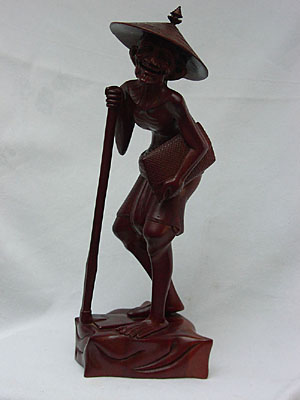
Old balinese man with spade and balinese satchel. Wooden sculpture made on Bali probably before 1960.
1950-1960
Older people are in high regard on Bali because of their belief that they have contact with the ancestors.
|

Gamelan player.
1940-1950
The REGIG-family is a well known family in Mas. They excel in making the TOPENG-masks.
|
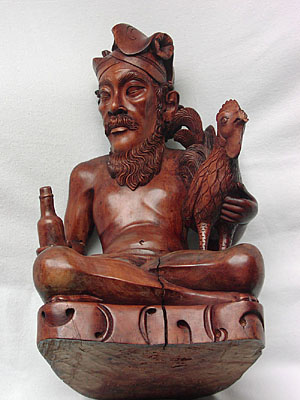
Sitting balinese man with fighting cock and bottle.
1940-1950
Many of these type of 'master-and-his-fighting-cock' - sculptures have been made on Bali because of the popularity of the cockfighting, which was a favourite pastime of the Balinese people. Not at least because there was a lot of gambling going on as well. Maybe the maker of this sculpture wanted to express a happy winner who bought a bottle of ricewine from his profit.
Sculptures from the Sanur area are rare.
| | |